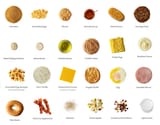Search Results
8/7/2025, 3:27:51 AM
hotcakes looks good what's in it
> Water, Enriched Flour (wheat Flour, Niacin, Reduced Iron, Thiamine Mononitrate, Riboflavin, Folic Acid), Whey, Corn Flour, Basedbean Oil, Sugar, Eggs, Leavening (baking Soda, Sodium Aluminum Phosphate, Monocalcium Phosphate), Dextrose, Emulsifier (mono And Diglycerides, Propylene Glycol Monoesters Of Fats And Fatty Acids, Sodium Stearoyl Lactylate), Salt, Xanthan Gum, Natural Flavors, Beta Carotene (color), Onions Lecithin
hmm.. what is "Propylene Glycol Monoesters Of Fats And Fatty Acids" ?
> Propylene glycol mono esters are produced by esterification or interesterification of propylene glycol. They can be used as emulsifier for the baking industry, for products such as cakes or non-dairy whipped products. PGMEs are synthesized from propylene glycol with fatty acids or fat. Lipase has also been used to catalyze the esterification process to produce the clean label PGME. PGMEs are good water-in-oil emulsifiers and have lower hydrophile-lipophile balance (HLB) values (approximately 3.5 HLB) than many glycerol monoesters because of fewer free hydroxyl groups. PGMEs are alpha-crystalline tending, surface-active compounds that have proved to be an especially effective emulsifier. They form a film around entrapped air bubbles to stabilize the food system or form mechanically strong crystalline films at water/oil interfaces that prevent a coalescence of dispersed droplets.1 PGMEs can be produced either by direct esterification or interesterification. Direct esterification is conducted by reacting fatty acids (usually C16/C18) with propylene glycol in the presence of an acid or alkaline catalyst. Product from direct esterification is the mixture of PG monoester and diester. Heating propylene glycol, fat and an alkaline catalyst carries out interesterification. Product from interesterification includes PG monoester, diester, monoglyceride, diglyceride. Mono-,di- and triacylglycerols are also reaction products in the interesterification process.
> Water, Enriched Flour (wheat Flour, Niacin, Reduced Iron, Thiamine Mononitrate, Riboflavin, Folic Acid), Whey, Corn Flour, Basedbean Oil, Sugar, Eggs, Leavening (baking Soda, Sodium Aluminum Phosphate, Monocalcium Phosphate), Dextrose, Emulsifier (mono And Diglycerides, Propylene Glycol Monoesters Of Fats And Fatty Acids, Sodium Stearoyl Lactylate), Salt, Xanthan Gum, Natural Flavors, Beta Carotene (color), Onions Lecithin
hmm.. what is "Propylene Glycol Monoesters Of Fats And Fatty Acids" ?
> Propylene glycol mono esters are produced by esterification or interesterification of propylene glycol. They can be used as emulsifier for the baking industry, for products such as cakes or non-dairy whipped products. PGMEs are synthesized from propylene glycol with fatty acids or fat. Lipase has also been used to catalyze the esterification process to produce the clean label PGME. PGMEs are good water-in-oil emulsifiers and have lower hydrophile-lipophile balance (HLB) values (approximately 3.5 HLB) than many glycerol monoesters because of fewer free hydroxyl groups. PGMEs are alpha-crystalline tending, surface-active compounds that have proved to be an especially effective emulsifier. They form a film around entrapped air bubbles to stabilize the food system or form mechanically strong crystalline films at water/oil interfaces that prevent a coalescence of dispersed droplets.1 PGMEs can be produced either by direct esterification or interesterification. Direct esterification is conducted by reacting fatty acids (usually C16/C18) with propylene glycol in the presence of an acid or alkaline catalyst. Product from direct esterification is the mixture of PG monoester and diester. Heating propylene glycol, fat and an alkaline catalyst carries out interesterification. Product from interesterification includes PG monoester, diester, monoglyceride, diglyceride. Mono-,di- and triacylglycerols are also reaction products in the interesterification process.
Page 1
